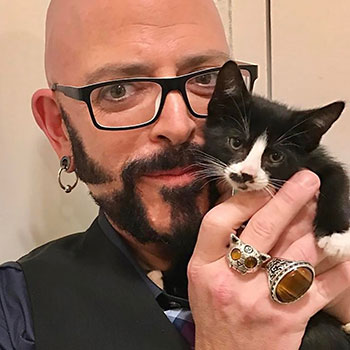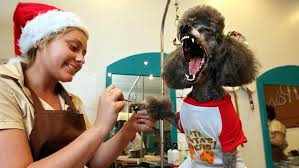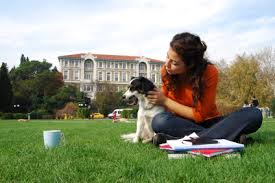Creating A Cat Friendly Home
Jackson Galaxy, Catification
 Cat expert Jackson Galaxy is back. This time he has great ideas for turning your house into a cat-friendly playground without losing its aesthetic appeal. It's not enough to just have a feeding bowl and litter anymore. Cats need stimulation. Jackson has a plan, even if you're a renter.
Cat expert Jackson Galaxy is back. This time he has great ideas for turning your house into a cat-friendly playground without losing its aesthetic appeal. It's not enough to just have a feeding bowl and litter anymore. Cats need stimulation. Jackson has a plan, even if you're a renter.
Jackson Galaxy has a book called "Catification" which is about creating feline-friendly environments that cater to a cat's natural instincts to climb, perch, rest, play, and own their space. There has never been a book that tells you how to pimp out your house for your cats until now!
If Jackson had to re-trace everything from 20 years of going to people's houses, these are the things he tells his clients. Cats need to go in high places; they need to scout out the world in a safe way; they need to get away from one another; and they need more litter boxes. Whatever it is, there is always that resistance that if you do anything environmentally for your cat, suddenly you're a crazy cat lady.
Most people think that cats are solitary animals that sleep all day and that if they have a bed, bowl and litter box, there is nothing else they need. This is where Jackson comes in with his education. We might think that cats sleep all day, but in reality, a study showed that they spent more time looking out the window than even sleeping. So why not engage them, even when they are in that passive state.
If you don't, at some point you are going to pay the price for their sedentary nature. They might beat up on another cat. They might start marking your house because they have all of that built up static electricity in their bodies.
Jackson wanted to prove that you could create a great environment for your cat and do it without sacrificing your own aesthetic. You can also do it for very little money, or you can do it for a lot of money. You can do it for a little work or a lot of work. But basically, there is no excuse to not make your house attractive to your cat.

But what if you rent? You don't want to get on the bad side of your landlord by putting holes in the walls. Don't worry, many of the projects in the book cater to people who rent and are therefore limited as what they can do to their home.
One thing a renter can do is create a cat superhighway. This is where your cat can go from the couch, to the bookcase, to the mantle and around the room without touching the floor. You can create one without putting a thing into the wall.
Jackson explains something to us, which he calls "cat geometry" or "cat chess." This is when you have a multi-cat home and one cat walks in room, they are looking at every move they can possible make. Such as, where are the escape routes, where are the ambush points and where are the hot zones. The one cat that tends to beat up on the others, is working towards "checkmate" the entire time, such as where can they cut off the path of another cat. They work this stuff out in the blink of an eye! Again, by giving them a super highway, by giving them exit routes and by giving them perching places, you're cutting off all of the negative cat geometry and all of the cat chess, because now the bully can't cover all of the exits at the same time.
So don't wait until something goes wrong. Educate yourself about what cats really are and what they really need. They are incredibly bright and active hunters and if we environmentally build things up for them, then we're heading a lot of problems off before they occur.
We "get" dogs but we don't "get" cats. In the meantime we try to treat them like dogs, which doesn't work, so let's get educated!
Visit Website
Charlotte Ross
 Actress Charlotte Ross guests this weekend. This charismatic fireball loves the animals. You've seen her on Glee, NYPD Blue, Nashville and Arrow. But her biggest role is being a voice for the voiceless.
Actress Charlotte Ross guests this weekend. This charismatic fireball loves the animals. You've seen her on Glee, NYPD Blue, Nashville and Arrow. But her biggest role is being a voice for the voiceless.
Charlotte Ross has been an animal activist for years. Ever since she was a little girl she's had this dream of helping any way she could. Nowadays, anytime someone wants to collaborate and help to bring awareness and raise funds for animal organizations, Charlotte is on board.
Charlotte says she is a foster failure and explained to her son that they can't keep continuing to foster if they don't understand they eventually will have to go to a permanent home. Her dog Tyler was adopted in Los Angeles. She also brought back 5 dogs from Puerto Rico when she did a movie there and adopted out 4 and kept one named Taco, who passed away at the age of 18. Charlotte is not quick to replace her dogs, so she devotes her time to fostering. One day she was fostering 4 puppies and felt that Tyler, who might be a little overweight, needed a friend to play with. When one of the puppies sat on Taco's grave, Charlotte knew that it was the right moment and the right dog. She named her Sadie.
Aside from her extensive acting resume, she has also received much acclaim for her work in philanthropy.
Visit Website
"HERO PEOPLE OF THE WEEK" - Joe Dwyer & Daniel The Beagle
 Our Hero Person this week is trying to put an end to an archaic method of euthanization. Currently, only 2 states still use the gas chamber, Missouri and Wyoming, to get rid of unwanted animals. Joe Dwyer adopted a dog that survived a gassing. Now the lucky dog, "Daniel," is the poster-dog for anti-gas chamber legislation.
Our Hero Person this week is trying to put an end to an archaic method of euthanization. Currently, only 2 states still use the gas chamber, Missouri and Wyoming, to get rid of unwanted animals. Joe Dwyer adopted a dog that survived a gassing. Now the lucky dog, "Daniel," is the poster-dog for anti-gas chamber legislation.
In October of 2011, Daniel's life nearly ended. When Daniel was only six months old, he was placed into a small steel box alongside 17 other dogs scheduled for euthanasia at a Florence, Alabama animal control facility. The box was pumped full of carbon monoxide gas and while all of the other dogs succumbed Daniel miraculously survived. He was only one of two dogs who have ever survived the gas chamber.
He was immediately named Daniel for the biblical figure who survived after being thrown into a den of lions. After his ordeal, he was taken to a veterinarian for treatment. Daniel was then transferred to the Eleventh Hour Rescue in Rockaway, New Jersey. There, he caught the attention of motivational speaker Joe Dwyer, who ended up adopting him.
 There are currently only 2 states that are using the gas chambers to euthanize animals. It has become the mission of Joe Dwyer and Daniel to raise awareness and to outlaw the use of gas chambers, which has been very successful, and hey have had influence in several states since Daniel survived to ban it. Gas chambers are also costly to operate and it actually costs less per animal to do a more humane euthanization with a sedative injection.
There are currently only 2 states that are using the gas chambers to euthanize animals. It has become the mission of Joe Dwyer and Daniel to raise awareness and to outlaw the use of gas chambers, which has been very successful, and hey have had influence in several states since Daniel survived to ban it. Gas chambers are also costly to operate and it actually costs less per animal to do a more humane euthanization with a sedative injection.
Besides trying to ban gas chambers, Daniel went around to schools to educate our youth using his story of surviving the toxic gas chamber by trying to relate it to the emotional toxins that a lot of our high school students have, such as peer pressure and bullying, and then also trying to get them interested in dong the right thing for animals.
For more information about what you can do to ban gas chambers in the remaining two states, visit the American Humane Association website.
Visit Website
How to NOT Train a Dog - Dr. Debbie

One day I was walking my dog in a community area and encountered a lady with two Shih Tzus. As we approached, her dogs rallied with barking and tugging on their leashes. I asked if her dogs were friendly, so as to decide if we could approach. The lady scowled, embraced her still barking dogs and grumbled, "Do they look like they're friendly?"
Realizing this dog owner was more unsociable than her dogs, I decided to vamoose, but not before I envisioned this blog topic - how pet owners mold unsocial dog behavior.
Unwanted doggie behavior such as lunging and barking on the leash become established when the dog owner hasn't made it clear what the appropriate behavior is, fails to correct and redirect to a more suitable behavior, or simply reinforces the undesirable behavior through actions or words. Face it - there aren't bad dogs, just poorly trained ones.
Avoid making these top 5 training mistakes:
1. Secluding Your Dog in the Backyard
Keeping your dog in lock down almost guarantees problem behaviors will develop such as biting, inter-dog aggression and phobias to anything from noises to car travel. Isolated dogs lack the experience and confidence when faced with novel situations while socialized dogs adapt easily.
I see it all the time - the dog owner prides herself in keeping her dog safe. "I didn't want Fido to catch any diseases as a pup, so I didn't let him out of our backyard till he was a year old." The overwhelming fear of infectious diseases like parvovirus causes some well-meaning owners to confine their new dog or puppy to the limits of house and yard. Even more extreme is never allowing a puppy to step foot outside until after their last puppy vaccinations! Puppies are most adaptable to new experiences between 6 and 16 weeks - this is the time to expose them to unfamiliar places, people and animals.
That doesn't mean you should take your eight week old puppy to dog parks, but rather to use good sense selecting low dog traffic areas and visiting with family and friends outside of the home that have properly vaccinated pets.
2. Skipping Obedience Training
Going to school is a must for any new dog to a home, whether a puppy or adult. No two dogs are the same, and each learns differently. Formal obedience training is a useful tool to gently reaffirm who's in charge and sets the rules in the house. Statistics show that dogs that go through formal obedience training are less apt to develop behavior problems and be relinquished to shelters.
 3. Reinforcing Fear at the Veterinary Office
3. Reinforcing Fear at the Veterinary Office
In the exam room I cringe when I see a dog owner comforting a nervous, fearful or aggressive pet. That "good boy" and pat on the head reinforces your dog's behavior, making it more likely that on the next hospital visits he'll behave the same, or worse. Some problem behaviors escalate making it difficult for the veterinary staff to examine or treat the animal. This may mean additional costs for sedation or anesthesia for routine medical needs.
It's natural for a pet owner to want to reassure a pet when he is frightened and it can be difficult to hold back the urge to soothe him. However, the best strategy is to ignore those fearful behaviors in the vet office. Don't be tempted to kiss, snuggle or hold Fido on your lap when he is misbehaving. Rather, place the dog on the floor, refocus your dog's attention to you, and cue him to "sit" or "lie down."
4. Not Using Food as a Reward
Food shouldn't just be for the taking. Don't leave food out for your dog to graze whenever he wants and don't give treats just for the sake of giving a treat. Present food and treats as a reward for good behavior such as sitting quietly, going to a pillow, or performing a trick or obedience work. This places you at the top of the household hierarchy. You become the provider of great edibles in the house, and your dog will be motivated to listen to your requests in other situations.
We all love to spoil our dogs and give treats at times. But be sure to give treats for a reason, or you will have a spoiled doggie brat on your hands.
5. Not Exercising Your Pet Enough
Inadequate exercise can result in obesity and boredom, and may lead to problem behaviors like separation anxiety, destructive chewing and excessive barking. Dogs should get 30 to 60 minutes of sustained physical activity each day for optimum mental and physical benefit. And no - letting Buffy run around the backyard during the day is not adequate exercise.
Not all breeds are cut out for all exercise - a Labrador may enjoy retrieving games or swimming, a Jack Russell terrier may thrive with jogging or Frisbee, while a Basset hound will be satisfied with a leash walk.
Your dog can't be a well-adjusted, socialized canine citizen without you, as the pet owner, taking an active role in training. Put the time in, and you'll be thanked many times over with an outgoing, friendly canine pal that can accompany you on life's adventures.
Featured veterinarian known as "Dr. Debbie" on national pet radio program, Animal Radio. Ebook author of "Yorkshire Terriers: How to Be Your Dog's Best Friend"; "Pugs: How to Be Your Dog's Best Friend"; "Mini Schnauzers: How to Be Your Dog's Best Friend"; and "Shih Tzu: How to Be Your Dog's Best Friend." Dr. Debbie's books.
Visit Website
 The Dogfather's Grooming Tip with Joey Villani
The Dogfather's Grooming Tip with Joey Villani
How To Secure A Holiday Grooming Appointment
Joey received an email from someone who has a shorthaired mixed dog that is going through extreme shedding. And coming into the Holiday Season, which usually starts around the second week of December, everyone wants to get their pets in to be groomed. The big problem is that they want to stretch it out. This means that they don't want to have their pets groomed now, through the month of November, so they will put it off so it will be done for the holidays.
This is the biggest mistake you can do. This time of year, especially in December, is a big part of a groomer's season. Things seem to quiet down in the grooming world by January, where everyone seems to be broke and kids have gone back to school.
The smart thing to do is to have your pets groomed real well now! Have them groomed right before Thanksgiving. Most groomers don't like to do heavy haircuts; they like to do grooming touchups. By grooming your pet in November, this makes you the perfect candidate for an appointment in December. Your groomer can now get you in and get you out real quick, for just a touchup. This allows a groomer to service a lot more clients and keep people happy.
 You should always stick to your same groomer that your pet is happy with, even under a time crunch. There seems to be a lot more injuries during the holidays, when people start taking their pets to unfamiliar groomers.
You should always stick to your same groomer that your pet is happy with, even under a time crunch. There seems to be a lot more injuries during the holidays, when people start taking their pets to unfamiliar groomers.
So, get your dog groomed in November and get the holiday touchup grooming in December and everyone will be happy. But, if you try to push it, you may not get in. That is just how it is - there are not enough groomers to go around!
Animal Radio News with Tammy Trujillo
 Actress Leaves Money to Animals
Actress Leaves Money to Animals
If you're into classic Hollywood, you know who Joan Fontaine is. The Academy Award-winning actress died at the age of 96 years old. Animal lovers won't forget her soon. Proceeds from the sale from her home in Carmel, California went go to the Society for the Prevention of Cruelty to Animals for Monterey County, as well as the sale of it's contents, including the Oscar she won for her role in Alfred Hitchcock's 1941 film "Suspicion."
Do Therapy Animals Get Stressed?
Scientists at the Vetmeduni Vienna investigated how therapy dogs feel in a therapy setting and how to create a largely stress-free situation for the animals. The keys turned out to be whether the dogs were on a leash and were permitted to leave the room at any time and if they were provided water they could get to when they wanted. The study showed that, under those conditions, the dogs stress levels did not go up. The results were published in the Journal of Veterinary Behavior.
Do You Miss Your Pets When You Vacation?
A website survey by the site Wotif said that 10-percent of pet guardians who leave their pets at home when they go on vacation call them to talk on the phone, 4-percent sent their pet a postcard and 23-percent brought their pet a souvenir from the trip. More than four out of ten people can't leave their pets home and actually take them on vacation with them. And it's not just cats and dogs that are going; birds, rabbits, reptiles and fish are going on vacations as well.
 Studies Show Pets Help College Students
Studies Show Pets Help College Students
Animal-assisted therapy can reduce symptoms of anxiety and loneliness among college students. That's the result of a study done by researchers from Georgia State University, Idaho State University and Savannah College of Art and Design. They provided a therapy dog to students twice weekly. The students could interact with her for as long as two hours and got to pet, hug, feed, brush, draw, photograph, sit near and play fetch with her. Researchers found a 60-percent decrease in self-reported anxiety and loneliness symptoms following the sessions. This was one of the first studies to apply animal-assisted therapy in a group college setting and use a systematic form of measurement. It suggested that animals could be a good way for college counseling centers to help students.
 Listen to the entire Podcast of this show (#1249)
Listen to the entire Podcast of this show (#1249)





